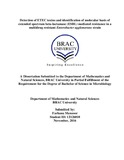| dc.contributor.advisor | Mannoor, Kaiissar | |
| dc.contributor.advisor | Choudhury, Naiyyum | |
| dc.contributor.author | Manzoor, Farhana | |
| dc.date.accessioned | 2017-11-30T07:24:56Z | |
| dc.date.available | 2017-11-30T07:24:56Z | |
| dc.date.issued | 2016-11 | |
| dc.identifier.other | ID 12126010 | |
| dc.identifier.uri | http://hdl.handle.net/10361/8554 | |
| dc.description | This thesis report is submitted in partial fulfillment of the requirement for the degree of B.Sc in Microbiology, 2016. | en_US |
| dc.description | Cataloged from PDF version of thesis report. | |
| dc.description | Includes bibliographical references (page 57-60). | |
| dc.description.abstract | Enterotoxigenic Esherichia coli (ETEC) is one of the salient causative agents of diarrhea particularly in developing countries and renders a major health complication in travelers to endemic areas. Eventually, infections caused by Extended Spectrum Beta Lactamase (ESBL) producing bacteria have been emerging worldwide and to avoid the inefficacy of the initial antibiotic regimen, rapid detection of ESBLs in Enterobacteriaceae is now in utmost priority. The study aimed to differentiate toxin producing ETEC strains as well as to determine antimicrobial resistance spectrum in a set of ETEC isolates collected from diarrheal patient. A multidrug resistant Enterobacter agglomerans strain was also characterized both phenotypically and genotypically for ESBL production. Toxin ELISA and multiplex PCR were performed to detect ETEC toxins along with antimicrobial sensitivity towards 13 different antibiotics by disk-diffusion method. Combination disk test was done to characterize multi-drug resistant Enterobacter agglomerans strain phenotypically, whereas conventional PCR using gene specific primers and Sanger sequencing were conducted to identify the resistance genes. Among 50 ETEC strains, 14 were positive for LT, 20 for ST and 16 for both ST and LT type toxins. The most prevalent subtype of ST toxin was STh (72%) over STp (28%). According to resistance pattern, more than 80% of the strains were resistant to Ampicillin and Erythromycin. About 90 % of ETEC strains were resistant to more than two antibiotics. Among different ESBL types, ESBLA was phenotypically identified through combination disk test. Conventional PCR using specific primers found the existence of the ESBLA subtype CTX-M1 gene and the primer amplified product size was about 841bp. Nucleotide sequencing and subsequent nBLAST analysis revealed 99% similarity with homologous bacterial strains including Klebsiella pneumoniae, Salmonella enterica, and Escherichia coli harboring the resistance gene. Alarming escalation of antibiotic resistance impedes the treatment and prevention of infectious diseases, resulting in increased mortality and morbidity. Therefore, development of alternative strategies needs to be propagated for resolving the serious problems due to multi-drug resistance pathogens. | en_US |
| dc.description.statementofresponsibility | Farhana Manzoor | |
| dc.format.extent | 72 pages | |
| dc.language.iso | en | en_US |
| dc.publisher | BRAC University | en_US |
| dc.rights | BRAC University thesis are protected by copyright. They may be viewed from this source for any purpose, but reproduction or distribution in any format is prohibited without written permission. | |
| dc.subject | ETEC toxins | en_US |
| dc.subject | Enterotoxigenic Esherichia coli (ETEC) | en_US |
| dc.subject | Diarrhea | en_US |
| dc.subject | Extended Spectrum Beta Lactamase (ESBL) | en_US |
| dc.subject | Bacteria | en_US |
| dc.title | Detection of ETEC toxins and identification of molecular basis of extended spectrum beta-lactamase (ESBL) mediated resistance in a multidrug resistant Enterobacter agglomerans strain | en_US |
| dc.type | Thesis | en_US |
| dc.contributor.department | Department of Mathematics and Natural Sciences, BRAC University | |
| dc.description.degree | B. Mircobiology | |

